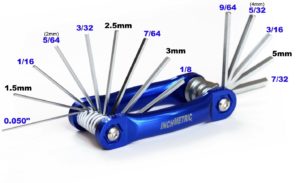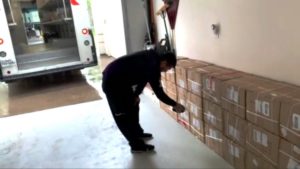By Ben Langlotz
|
June 3, 2021
|
Firearms
|
0 Comments
FREE* TOOL!

Free, but not cheap?
I’ve been writing about my adventure trying to launch not just a new product, but a new concept. My InchMetric® Hybrid® hex key tool has been moving forward since I last reported. The patentable concept is hopefully conveyed clearly in the picture above, which is worth a thousand words in a patent application talking about “intermixed according to size regardless of standard”. There are plenty of ups and downs to report.
So, I hired an old pal and he got to deal with unanswered examiner phone messages and emails, and he ended up filing an appeal of the examiner’s error. His staff was kept busy with the details, freeing up my staff for your details. Since then, the Appeals Board sent the examiner a message that’s best summed up as: “Get back to work, and if you’re gonna rejection the application then do it right.” This led to another real rejection that we addressed by employing one of my favorite strategies when things are going wrong:
I like to do it in threes. When things aren’t going well, I try to find three things to change to really shake things up, and dislodge matters. Often a problem is psychological, and someone’s way of thinking needs to change. As here. So, #1: I shook the box by bringing in a different attorney.
#2: I also thought we should offer to send a sample of the product to the examiner. This isn’t necessary, and mostly occurs in old New Yorker cartoons that’s I’d post an example of except for the $300 licensing fee. Imagine two cavemen in the waiting room chairs, both holding similar boulders, the one father from the patent examiner’s door giving the other a dirty look. Or a guy in a suit with an apparatus on his lap asking the caveman closer to the door with a fire burning in front of him on the floor: “Been here long?”
Anyway, the examiner balked at getting a free sample and we knew he’d never see it, so we opted to send lots of product images to shake up the notion that this was just an “invention” because it’s a real product, and that merits a different subconscious level of respect.
Then, the #3 shake of the box was in the substance of the case. “Let the Wookie win.” Or at let him feel like he won. I came up with a way to make a change in our strategy look like abject surrender. Instead of fighting where the examiner was wrong, we took a path that treated him like he was right, and bowed down before him. For the curious, we didn’t just push the “mixed and arranged solely by size” angle where we expect eventually to win. I added the limitation that sometimes there’s one inch (SAE) wrench between adjacent metric ones, and sometimes there’s more than one intervening. This should feel to the examiner like it’s extremely narrowing, but it’s not possible to produce a useful product without this kind of irregularity of spacing arrangement. In fact, some prior art tools have alternating slots that make things even, but make it impossible to arrange purely by size.
Wish me luck. I’ve learned that a day waiting for an examiner to act on your own case is like ten days waiting for them to act on a client case. So I understand your feeling of urgency much more vividly than before.

Rainy day delivery by our soggy FedEx driver.
I had measured and cleared space in the garage for the 33 cases of known dimensions. They arrived in a downpour. Still, I was elated after about six months since starting the project. It’s intimidating to have that much inventory, but it didn’t take long for the pile to start getting smaller and my floor space to be regained.
I had a sale for my 1000 Facebook friends, and started shipping. I have a Shopify sales website (inchmetric.com, but don’t buy there just yet) that’s pretty easy to operate, and I now have my own fulfillment business (18-month-old Sally likes carrying the packages out to the mail box). Even a good day represents dozens of dollars of profit, so I won’t be quitting my day job soon. The objective is to get the concept noticed and licensed by major makers.
One little thing I learned: thermal printers make sense, but they don’t seem to be available in wireless. It’s nice to be able to print out “free” labels and stick them on, instead of wrestling with FedEx pouches and later printed sheets folded inside.
• Fulfillment by Amazon (FBA) is essential. Unless you get that, you aren’t on “Prime” and that means most shoppers will ignore you. Only if you have a well-known product that buyers will work hard to find should you try to go without.
• Pricing for Amazon services is a confusing maze.
• 15% commission on sales.
• Fulfillment is based on weight, plus an add-on for packaging, plus rounding up. When developing products, consider shipping cost weight thresholds when possible. I pay $3.78 for a 6-ounce tool – in addition to the sales commission. Four tools would be $4.90, but…
• If a customer buys multiples, you pay multiple times shipping ($3.78 each). This means you’ll want to set up things like three-packs to preserve profits on larger sales.
• The sales commission is on the full price, so you’re essentially paying commission on their shipping service.
• $3.78 didn’t seem bad for all the work and cost to ship. Then I realized that when a buyer gets “free shipping” it’s really “seller-paid shipping.” So when a non-prime buyer pays for shipping then Amazon gets paid *twice* for shipping.
• Shipping to Amazon from my garage isn’t bad. $7 per box. Stick on a label, put it at the front door, and UPS picks it up same day. Tip: it’s flat rate up to 50 pounds so my next production order will be in ~48 pound cases instead of 27 pound cases to reduce total shipping costs.
• Ship plenty. Amazon starts asking for more shipments based on sales performance. My initial shipments were too small, and it slowed sales as all the product got distributed to Amazon locations around the nation. Next time some will ship directly to Amazon from overseas.
Getting Amazon approval on new products and brands is a maddingly frustrating system. It must be robust on their end, but it can take days to get things squared away. Brand approval is interesting. My InchMetric registered trademark was rejected by Amazon’s enforcement arm because it’s on the “Supplemental Register” (no conflicts with anyone else’s rights, but arguably descriptive of product characteristics). OK. But my Hybrid trademark was accepted, even though it’s not yet registered. Odd. Lesson: a narrow design trademark or logo application might be an important adjunct to a Supplemental registration if you care about Amazon enforcement.
Amazon enforcement isn’t the most important reason to have a registered brand. I need Amazon reviews to help with the product launch, and those can be hard to get (this relates to my free tool offer detailed below). Amazon has a “Vine” program in which a seller lets Amazon give free product to its independent reviewers in exchange for reviews. My $14.99 tool might be a penny under their threshold that reserves this for high-value items – another of the million ways to screw up on Amazon the first time. But I hope to get that resolved, and to give away stuff to Amazon’s friends to get some more reviews on the listing.
The first bit of bad news is that recently Amazon ended the ability to comment on reviews. I couldn’t gently comment and offer to resolve the problem and make it right. I can’t even learn what happened to correct a hypothetical product design or manufacturing error. My Amazon Dashboard shows no returns of defective product (a couple percent returned in salable condition).
The next bit of bad news is that Amazon heavily weights verified reviews, and virtually ignores reviews by those Amazon customers who purchased directly. They seem to give an outside review by an Amazon customer who purchased elsewhere 1/6th the weight of an Amazon purchaser.
Adding insult to injury is that when Amazon sees an inconsistency between purchaser reviews and outside reviews, they assume fraud, so they immediately cut off the ability of anyone other an Amazon purchaser to post a review.
So, I found my new product with a net 2 stars, with Amazon saying that 75% of reviews were 1 star (with their weighting). With that, it felt like I may as well shut down the business. This while looking at 4-5 month production time for the next batch and my garage already looking nearly half empty with shipments to Amazon and sales progressing nicely. Grrr.
But I did start getting some good reviews. I’m up to 3.8 stars at this writing (Six 5-star, One 1-star – you do the math), and now I’m asking for your help.
 or CLICK HERE— It’s embarrassing that before last year, I had no idea how these things worked, until I realized all you need to do it point the camera at them, then tap the link that pops up. After you get the tool, try it out, then pleasepleaseplease post a review. I suggest focusing on the benefits of the Hybrid® concept, but make it an honest review about anything you wish. After you do that, pop me an email to patent@langlotz.com with your paypal email address, and I’ll send you a full refund as my thank you. If you prefer, I’ll send the $15 to the Second Amendment Foundation.
or CLICK HERE— It’s embarrassing that before last year, I had no idea how these things worked, until I realized all you need to do it point the camera at them, then tap the link that pops up. After you get the tool, try it out, then pleasepleaseplease post a review. I suggest focusing on the benefits of the Hybrid® concept, but make it an honest review about anything you wish. After you do that, pop me an email to patent@langlotz.com with your paypal email address, and I’ll send you a full refund as my thank you. If you prefer, I’ll send the $15 to the Second Amendment Foundation.
If you’re interested in quantity (10, 60, more), let me know and I’ll send you to the inchmetric.com website. If you’d like 2000 or more with your brand in your color, we can arrange that too.
In any event, I’ll look forward to seeing you in Houston in September for the NRA show, whether or not they’ve managed to “D-Wayne the Swamp” by then. Thanks again for your support.